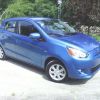Modifying the solenoid valve - Part 1

Alright, we have a 140 psi rated pneumatic solenoid valve that we want to modify to handle 1000+ psi for nitrous oxide. Sounds like a pretty drastic change, right? Well, it is and it isn’t. For our application, the change is pretty small. First, let's take this thing apart and see what we’re working with.

This is the first step of disassembly. The one nut on top holds the coil on, a metal cover, and a nameplate with some specs.

For the next step we have to disassemble the valve guts. It looks like you can use a beefy clip tool to remove things, but I just put it in my vise... Once clamped down, it turned easily enough by hand to take it apart.


This is what you find inside.


These are the bits to our solenoid valve. As you can see it's actually quite simple. The valve is spring loaded so it closes. To make the valve open, you energize the coil and it creates a magnetic field to pull up on the plunger to open it. De-energize the coil and the pressure and the spring push the plunger back down and the valve closes. Not too complicated, right?
So, how do we modify it? Well, we need to understand things a bit more to do that. Let's think about how this works a bit more. The valve only ever opens and closes. So, we need to consider both of those operations.
First, let's start with closing the valve. To close the valve at 140 psi, we have that pressure, plus the spring pushing the plunger down. If we increase the pressure to 1000 psi, we have even more help closing the valve. So, closing it should be no problem at all. It will definitely close at a higher pressure.
Now, let's think about opening the valve. To open the valve at 140 psi, we have to fight against that 140 psi plus the force of the spring. Once that valve cracks open, pressure is much closer to equalized on both ends of the plunger, and now you’re mostly just fighting the spring pressure. However, at 1000 psi, we are fighting that pressure plus the spring. Opening the valve will now require about 7 times more force (1000 / 140) to open. So, we have two options. The first one is to increase our magnetic power by 7 times. This will increase the force acting on the plunger, and be able to move it against the additional pressure. The second way is to reduce the amount of force necessary to open the valve at 1000 psi. This is what we will be doing.
So, you’re now wondering how we are going to reduce the force required to open the valve at 1000 psi. The key to this is the units of measure we’re using, psi or pounds per square inch. Our gas is pushing on that valve with 1000 pounds per square inch of opening in the valve orifice. The area around the plunger has no effect on the valve operation. Take a look at this diagram to help clarify.

If we look at the diagram, we can see that there is equal pressure pushing all over the plunger except for on the orifice, and the valve seating area. That 1000 psi is only pushing on that area. Therefore, if we reduce that area, it will take less force to pull the plunger up. This is what we will be doing.

There is obviously a trade off that is being made here. We’re reducing maximum possible flow for increased pressure capability. Our valve has a 2.5mm diameter orifice. We will be reducing it down to something smaller than that. So, this valve will not be able to flow as much as it did previously. Thankfully, for us this won’t be a problem. 2.5mm is big enough to flow over 300 horsepower worth of nitrous! We aren’t getting anywhere close to that, so we have ample headroom to reduce that orifice size.
Math time. We already figured out that we need roughly 7 times more force to open our valve. We need some cushion in case the tank pressure gets a little higher. So, I am going to aim for 1100 psi pressure rating. 1100 / 140 = 7.8 times more force. Or, we can say we need to reduce our orifice area by 7.8 times.
Our orifice is 2.5mm in diameter. This gives us an area of 4.9 square mm. If we divide that by 7.8 we get .629 square mm. Now, we convert that back to a diameter and get .9mm.
If we reduce the solenoid’s orifice size to .9mm, we should be able to operate it at 1100 psi. .9mm will also still flow 57 horsepower of nitrous, and that is likely more than I will ever use.
We could do this modification many different ways. The way I am choosing to do it is to get a 3/32 (0.094in / 2.38mm ) brass rod. This is just under 2.5mm (0.098in) in diameter and will slide right into the orifice. It will be cut to length, and I will drill a .9mm hole in the end to create the new orifice. The old seat will be ground off the valve. Then, the tiny drilled rod will be soldered into the valve to seal things up.
__________________________________________
 View my fuel log 2015 Mirage DE 1.2 manual: 47.2 mpg (US) ... 20.1 km/L ... 5.0 L/100 km ... 56.7 mpg (Imp)
View my fuel log 2015 Mirage DE 1.2 manual: 47.2 mpg (US) ... 20.1 km/L ... 5.0 L/100 km ... 56.7 mpg (Imp)



 2015 Test Mirage
2015 Test Mirage Swarthy
Swarthy
 Reply With Quote
Reply With Quote
 Speck
Speck

 Ghost
Ghost Onyx
Onyx

